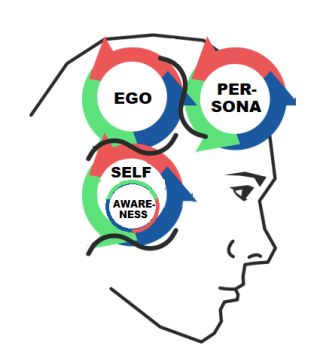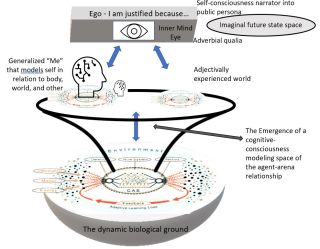MINDFULNESS- What Is the Difference Between the Self and the Witness? The distinction is crucial between witness consciousness and the self. Reviewed by Ray Parker

KEY POINTS-
- There is a difference between witness consciousness and the self.
- Witness consciousness refers to the process of cultivating "pure awareness" without judgment of good or bad.
- The self grips the world and motivates you to act in service of your interests.
- Buddhism has long clarified the difference; modern psychology needs to be more explicit about it.

In mapping human consciousness, what is the difference between the witness function and the self? If you had asked me this question 15 years ago, as I was writing my first book, A New Unified Theory of Psychology, I probably would not have been able to give you a quick answer.
I say that with some degree of embarrassment, as the distinction between witness consciousness and the self is fundamental. Thankfully, it was clearly part of my model, but it was more implicit than it should have been and it was not something I had specified with the necessary clarity.
Thankfully, as these two videos on human consciousness and the self illustrate, the model has evolved to address this issue, and the difference is now effectively and explicitly framed in my Unified Theory of Knowledge (UTOK).
The Difference Between Witness Consciousness and The Self
The distinction between the witness function and the self is made clear and explicit in Buddhism. Indeed, as Robert Wright notes in his work, Why Buddhism is True, learning to see the world via “witness consciousness” as opposed to gripping the world via the self is, arguably, the central insight in Buddhism. At its core, Buddhism is about detaching from the self and living through witness consciousness.
So, what exactly is witness consciousness? It refers to the “pure” sensory-perceptual aspects of your conscious experience. The best way to see it, I think, is to simply close your eyes and open your eyes. When we do this the world is simply presented to us before any reflective thoughts, actions, or narratives come into play.
This raw experience is available to us via the witness function. It can be thought of as a portal through which we become consciously aware of our surroundings. Note that this little exercise of opening your eyes and “seeing” is just a starting point for really grasping the difference between the witness and the self.
As Wright notes in his book, to really live through the witness function requires training and practice. This can be done through training in meditation or yogic practices, or through some coaching programs, like Rob Scott’s Fundamental Shift.
If the pure sensory-perceptual experience of what Scott calls “isness” is part of witness consciousness, what is the self? As described in this post on Waking Up to the Identity Matrix, the self is the portion of your consciousness that grips the sensory-perceptual input and then judges what it means.
The Self and Its Different Layers
The most basic elements of the self are drives and feelings like pleasure and pain, which orient the self toward desires and make judgments about what is good or bad. As this post on the layers of the human psyche points out, the base of pleasure and pain is the core of your animal self. We can move up to your “primate self,” which is concerned with things like status and attachment.
This is different from your narrating human ego. This is the portion of your consciousness that reflects on your experience and is concerned with whether you are justified according to your values and worldview. Finally, there is your persona. This is the portion of your consciousness that manages the social world and the impressions you make, and it focuses on things like your reputation and how you appear to others.
Notice that these aspects of the self are about making judgments about what ought to be. And this is the key difference between the witness function and the self. The former is simply about perceiving what is. By this, I do not mean perceiving what is in the scientific sense.
Rather, I mean perceiving what is presented in the field of conscious experience. In contrast, the self is about grabbing what is, making judgments and meaning, and then orienting the person toward what ought to be.
The Witness Function and The Self in Buddhist Thought
As Wright notes, perhaps the central tenant in Buddhism is to train oneself in the difference between the self and the witness and learn to live much more through the witness function.
To make the point about the difference, here is a section of a poem in Wright’s book from a sixth-century Chinese monk known as the Third Patriarch of Zen. It begins with the lines:
The Great Way is not difficult
for those who have no preferences,
When not attached to love or hate,
all is clear and undisguised.
Separate by the smallest amount, however,
and you are as far from it as heaven is from earth.
If you wish to know the truth,
then hold no opinions for or against anything.
I find this to be an interesting passage. One reason is that it seems to open some potential ethical conundrums. Indeed, Wright shares the poem in the context of raising the question of whether the logical conclusion of Buddhism is an extreme form of nihilism grounded in a refusal to see good and bad values in the world.
But instead of tackling that controversy, let’s return to the point of this post. I shared the poem because I think it helps us to see the core difference between the witness function and the self.
We should be aware that difference has long been known to Buddhist scholars. And as my journey makes clear, it is underdeveloped in modern psychology. However, I believe that if we are really going to wake up to the identity matrix and evolve our collective consciousness in the future, it is absolutely essential that we make a clear distinction between the self and witness consciousness.
For readers who are more visually inclined, here are two diagrams that might help make sense of the claims in this post. This diagram maps UTOK’s ESP-A model of consciousness, which divides human consciousness into pure awareness (i.e., witness consciousness, the core primate Self, the human Ego, and the Persona). The circle inside represents the portal of pure awareness. It is then gripped by the primate "Self," and then narrated by the "Ego," all while the "Persona" considers impressions from others.

For a more detailed model that is consistent, but just gives a different angle, at left is the picture of the self that emerged from the Cognitive Science Show Series, the Elusive “I”: The Nature and Function of the Self. It shows the difference between the witness function and the self.
The "inner mind's eye" at the top of this diagram represents the witness function. The heads to the left of the diagram represent the model of the self across time that serves as the referent for what is good and bad for the self, both in relationship to the world in general and in relationship to others. Then there is the "Ego," which attempts to justify the self and narrate one's place on the social stage.
- Questions and Answers
- Opinion
- Motivational and Inspiring Story
- Technology
- Live and Let live
- Focus
- Geopolitics
- Military-Arms/Equipment
- Ασφάλεια
- Economy
- Beasts of Nations
- Machine Tools-The “Mother Industry”
- Art
- Causes
- Crafts
- Dance
- Drinks
- Film/Movie
- Fitness
- Food
- Παιχνίδια
- Gardening
- Health
- Κεντρική Σελίδα
- Literature
- Music
- Networking
- άλλο
- Party
- Religion
- Shopping
- Sports
- Theater
- Health and Wellness
- News
- Culture

